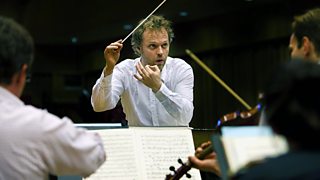This week, we spent three days recording with our Principal Conductor, , for the Linn Records label.
Regular readers of my blog will know that recording is a regular occurrence on our schedule. We do a tremendous amount of TV soundtrack work, and frequently record for . However, recording for commercial release is so different - I personally think it is the most pleasurable type of recording.
Commercial recordings put the orchestra in the spotlight, not as an accompaniment to the main attraction as is the case with TV work. It gives the conductor and orchestra the opportunity to spend highly focused time together, creating an interpretation they believe in and a recorded history of their relationship. That is quite a responsibility, and the intense nature of the process can feel somewhat claustrophobic, but it is also very exciting.

Thomas Sondergard at °èàùôÜä° Hoddinott Hall. Photo: Betina Skovbro
We started our journey on Wednesday afternoon, beginning with the second movement of the second symphony. I think texture-wise, this is the most complicated of the movements, with its plethora of independent lines pushing and pulling the music, first one way and then another, changing the direction of the music in a breath. In many ways I think this movement encapsulates Sibeliusã style; the broad brush strokes of the overall character and ãfeelã are determined by the accuracy and direction of the minutiae.
These sessions run along the lines of rehearse and record. We play through a large passage, perhaps even a whole movement, then break it down, concentrating on smaller sections. The red light, however, is always on, meaning that every take has to be like a performance, as itãs still being recorded.
When we rehearse, Thomas will frequently sing how he wants a passage to sound. I quite like this; itãs his job to bring his ideas to us, and itãs up to us to figure out the technicalities of how to bring his interpretation to life. Of course, when you think youãve got it, he will invariably ask for more, but that is the beauty of recording - when you listen back to takes your ideas donãt stay static, they develop and grow, and orchestra and conductor can challenge each other to dig deeper.
It was late on in the second day of recording when we got to my favourite movement - the finale. The fourth movement of the second symphony has a simple melodic theme and a number of rhythmic figures each vying to subjugate the other. As the music moves towards its climax, itãs like some colossal beast gathering everything to itself as it rises. The moment when the music moves to the major key for the final time, and the chorale builds up in the brass and wind, soaring along over the whole body of the strings rising up below them is indescribable.
Packing up on Thursday evening, knowing tomorrow we would be facing the much lesser known , it felt like we had already scaled a large mountain, only to find there was still another peak to go. For that evening however, it was home for a hearty dinner, many cups of tea, and a recuperative relax on the sofa!
